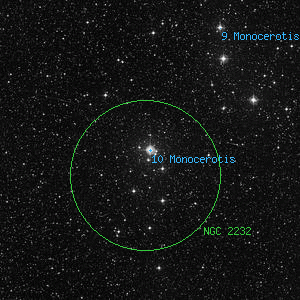10 Monocerotis

Overlaid DSS image of 10 Monocerotis, 60' x 60' with north at top and west to the right
Aladin viewer for the region around 10 Monocerotis
10Mon
BD-04 1526, HD 45546, HR 2344, SAO 133290, GSC 04793-02716, HIP 30772, WDS J06280-0446A
BD-04 1526, HD 45546, HR 2344, SAO 133290, GSC 04793-02716, HIP 30772, WDS J06280-0446A
| Type | Star |
|---|---|
| Magnitude | 5.04 | Right Ascension | 6h 27' 57.6" (2000) |
| Declination | 4° 45' 44" S |
| Constellation | Monoceros |
| Classification | B2V |
Observing Notes
Andrew Cooper
Dec 12, 2021 Waikoloa, HI (map)
20cm f/6 Newtonian, Cave Astrola @ 76x
Seeing: 6 Transparency: 7 Moon: 0%
Blue-white at the center of the bright and coarse cluster NGC 2232, the two 10th magnitude stars visible 1' west are both listed as companions B and C in WDS about 40" apart from each other, the nothern about half a magnitude brighter, oddly these two are not plotted in Sky Safari but are in the sky survey imagery
Andrew Cooper
Mar 24, 2020 Waikoloa, HI (map)
20cm f/6 Newtonian, Cave Astrola @ 61x
Seeing: 5 Transparency: 7 Moon: 0%
Blue-white, no companion noted
Captain William Henry Smyth
Dec 28, 1832 No. 6 The Crescent, Bedford, England (map)
150mm f/17.6 refractor by Tully 1827
A wide double star in an elegant group, on the Unicorn's right fore-knee: it is about 12½° in an occult line carried from Sinus a little to the west of Capella, and directly between β in the Lesser Dog and α Leporis. A 6, pale yellow; B 9, orange, with a comes to the south. Though this object is a capital one for testing the performance of a telescope, it has not been classed among the clusters [Herchel cataloged the cluster H VIII 25 in 1779 --> NGC 2232]. Piazzi, in his note upon 116 VI., says, "plures telescopicae simul conspicuas."
Monoceros was introduced into the firmament by Bartschius, among the delineations on his four-foot globe; it was, perhaps, out of regard to the husband of Kepler's daughter, retained by Hevelius, being now con- sidered as one of his constellations. It is concocted of the stellæ informes scattered about in the large space between Orion, Hydra, and the two Dogs, over a portion of the Milky Way. But though extensive it is not conspicuous, few of its gems rising to the 4th magnitude. It has been pretty well ransacked since its first appearance in the Prodromus Astronomiæ, and many capital pairs, nebulæ, and clusters have been reaped. The stars have been thus successively tabulated:Hevelius .... 19 stars Piazzi .... 95 stars
Flamsteed .... 31 Bode . . . . 220― A Cycle of Celestial Objects Vol II, The Bedford Catalogue, William Henry Smyth, 1844
Other Data Sources for 10 Monocerotis
Associated objects for 10 Monocerotis
Nearby objects for 10 Monocerotis
8 objects found within 120'
| 9 Monocerotis | Berkeley 73 | Czernik26 |
| HD 44131 | HD 46304 | NGC 2219 |
| NGC 2232 | NGC 2250 |
Credits...
Drawings, descriptions, and CCD photos are copyright Andrew Cooper unless otherwise noted, no usage without permission.
A complete list of credits and sources can be found on the about page
10 Monocerotis